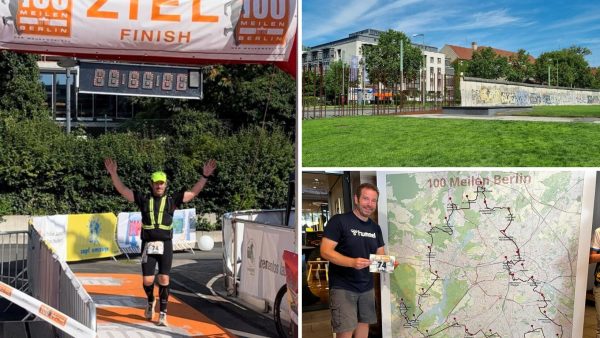
It’s hard to deny enjoying the outdoors – and engaging in activities that promote overall wellbeing – delivers many benefits. Embracing the great outdoors not only enhances our overall health but also contributes to a positive mindset and improved mental wellbeing. For one Urban Scientist, a commitment to wellbeing led him to the historic streets of Berlin, and in turn racing through history. Lutz Kalcker, regional PMO manager, recently participated in The Berlin Wall Race (Mauerweglauf) – a 100-mile ultramarathon1 that follows the path of the former border strip, which separated the city between 1961 and 1989.
Lutz is an avid runner and heard about the race after completing a local 50k (ok wow!) in his hometown of Frankfurt, Germany. To train for the 100-mile race he followed a rigorous three-month training schedule, which included many long runs on the weekends and after work.
“Rarely do we find marathons, let alone ultramarathons, so deeply intertwined with history,” said Lutz. “After conquering the Ironman2 triathlon five times, I found myself in search of a new, audacious challenge. The idea of running 100 miles may seem outlandish to some, but to me, it was the perfect adventure.”
Taking place August 17 and 18, the annual race commemorates the victims of the former border by hosting over 680 runners including individuals as well as two, four and 10 person relay teams from all over the world. Additionally, over 400 volunteers helped make the event a success by supporting runners along the tiresome journey with drinks and food at 26 refreshment stations coupled with kind words of motivation and comfort. The German Chancellor, Olaf Scholz, was also in attendance, talking with runners, organizers and volunteers at the start of the race. Those who received a medal for their performance showed the portrait of someone who lost his or her life in an attempt to vanquish the barbed wire and concrete of the Berlin Wall.
Making a difference as a blood donor
Many races are completed by runners participating to support a charity, also known as running with a charity bib. While Lutz didn’t complete the Berlin Wall Race under a charity this year, he plans to connect with DKMS – a nonprofit dedicated to the fight against blood cancer and blood disorders by creating awareness, recruiting bone marrow donors, raising funds to match donor registrations costs and supporting the improvement of blood cancer therapies by their own research – in the future.
Lutz, an avid blood donor and advocate for giving blood, began donating blood in 1997 and has donated over 50 times since then – helping approximately 159 people. Through his many donations, he learned more about blood cancer and disorders, and the need to expand donorship as only 30% of all blood cancer patients are able to find a compatible donor in their family.
Underscoring the pivotal role of blood and bone marrow donations, Lutz emphasized. “As of now, scientists can’t synthesize blood artificially, so I embraced the role of a blood donor many years ago as a simple, yet profound way to effect change and potentially save another person’s life. I wholeheartedly encourage everyone – in particular my fellow colleagues – to #DoGreatThings and join the cause by registering as donors to extend a helping hand to those in dire need.”
We salute Lutz for his commitment to wellbeing and #DoingGreatThings through volunteerism and activism. ここをクリック if you’re interested in registering as a donor with DKMS.
1 An ultramarathon is any footrace longer than the traditional marathon length of 42.195 kilometers (k).
2 An Ironman is a triathlon is one of a series of long-distance triathlon races organized by the World Triathlon Corporation, consisting of a 2.4-mile swim, a 112-mile bicycle ride and a marathon 26.22-mile run completed in that order, a total of 140.6 miles.

